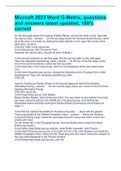Exam (elaborations)
MEDICAL-SURGICAL NURSING PART 1 Questions and Answers Grade Level 2023
- Course
- Institution
MEDICAL-SURGICAL NURSING PART 1 Questions and Answers Grade Level 2023 MEDICAL SURGICAL NURSING PART I Nurse Rene is caring for a client admitted to the hospital with suspected atelectasis. When assessing this client, Nurse Rene would expect which of the following? a. a respiration which is deep...
[Show more]












